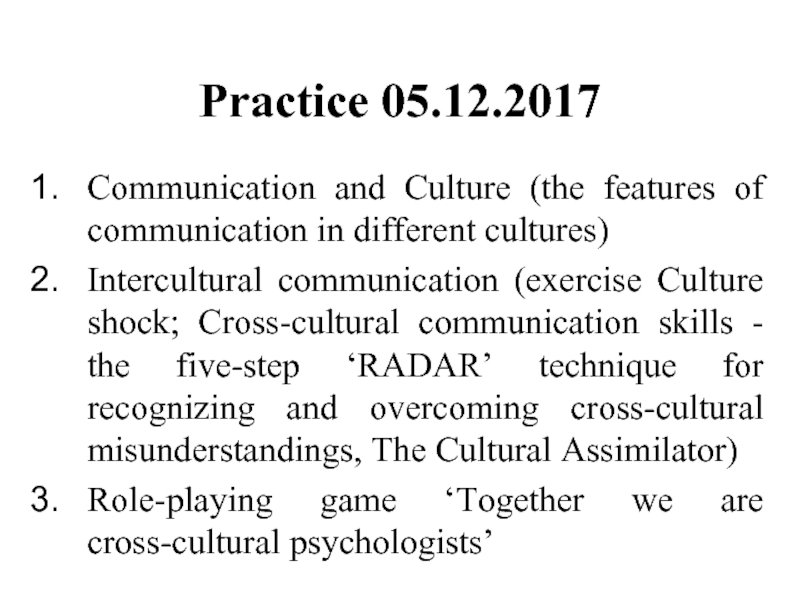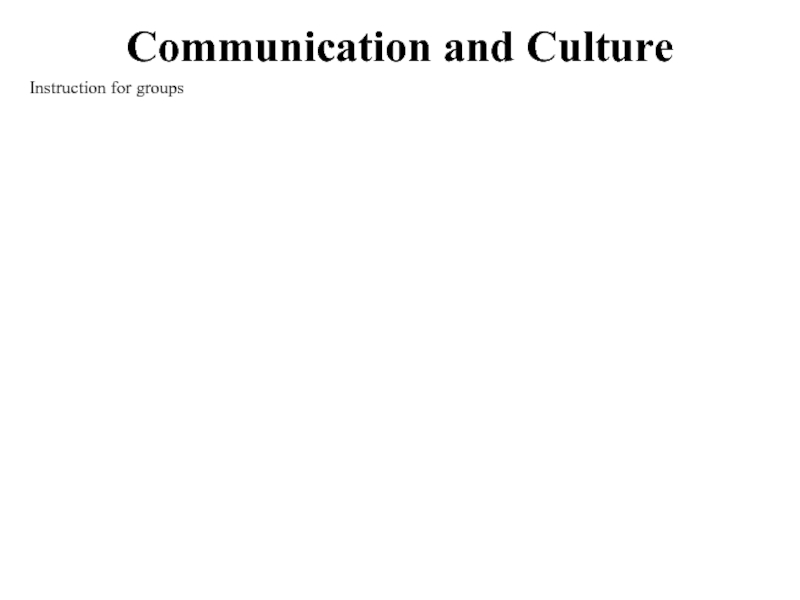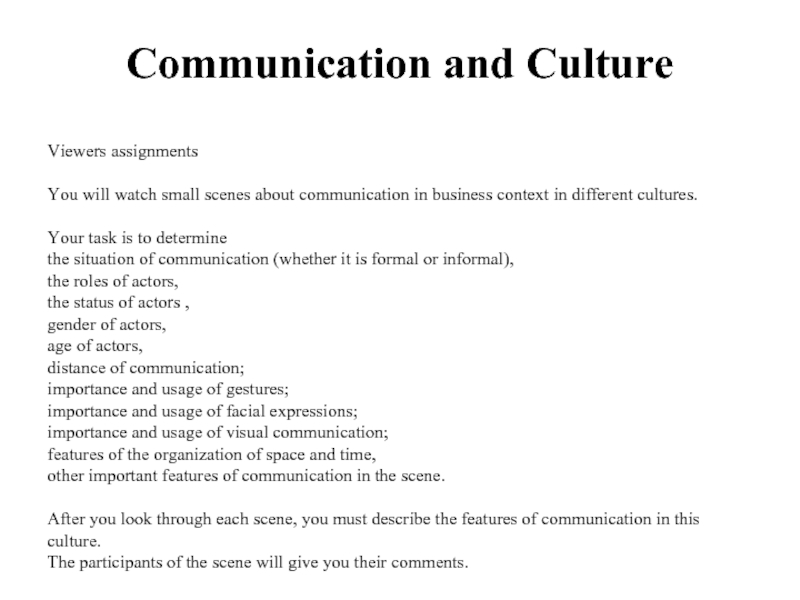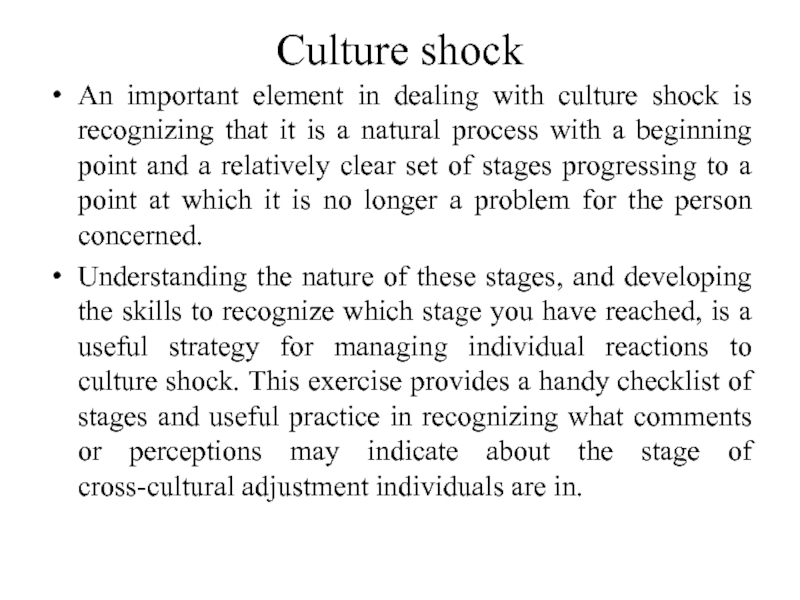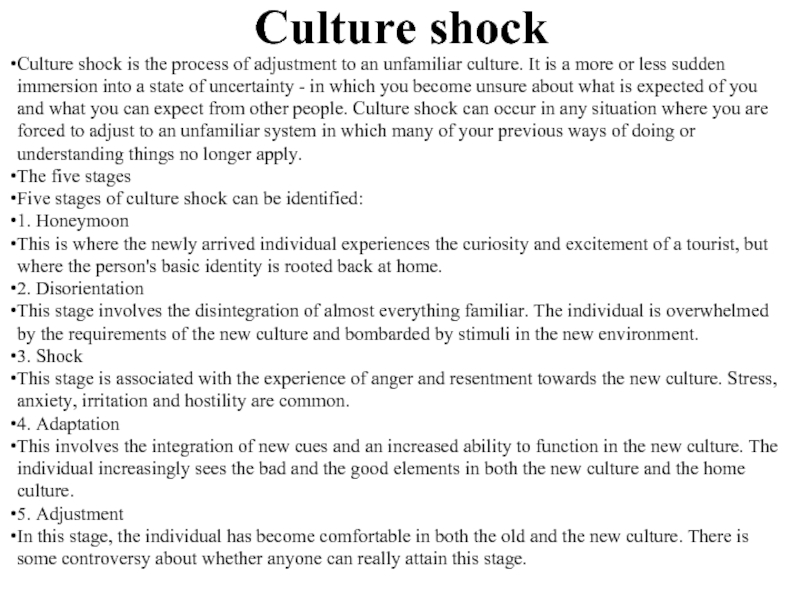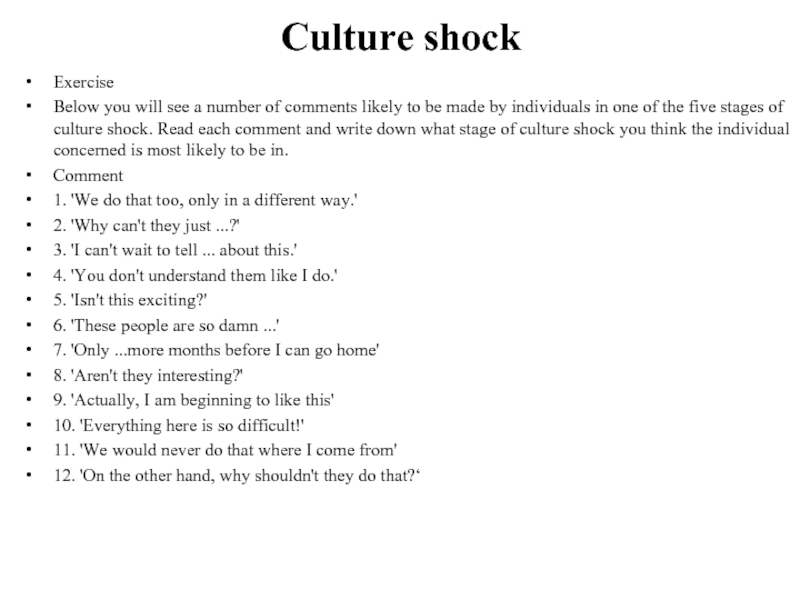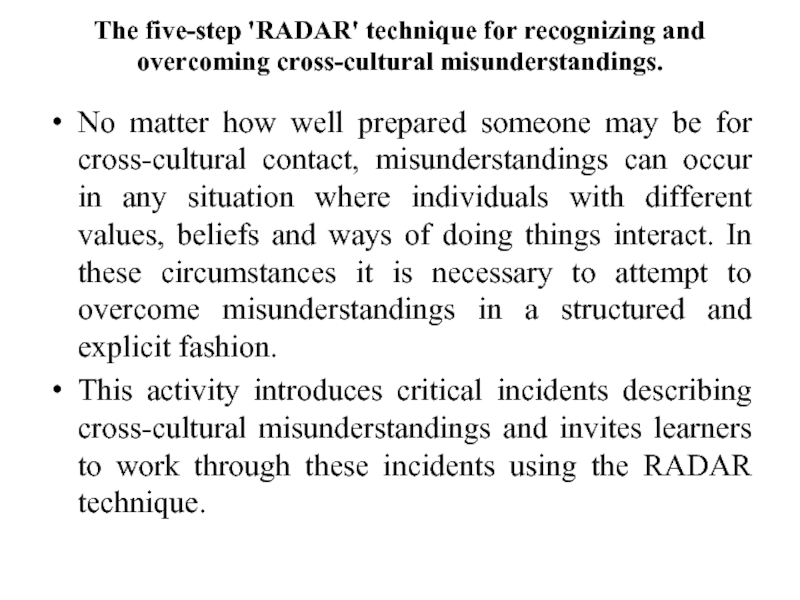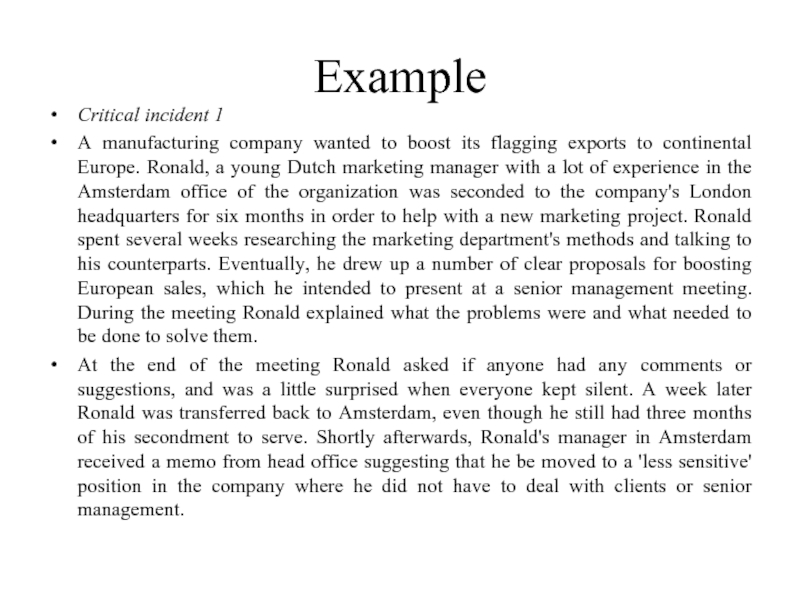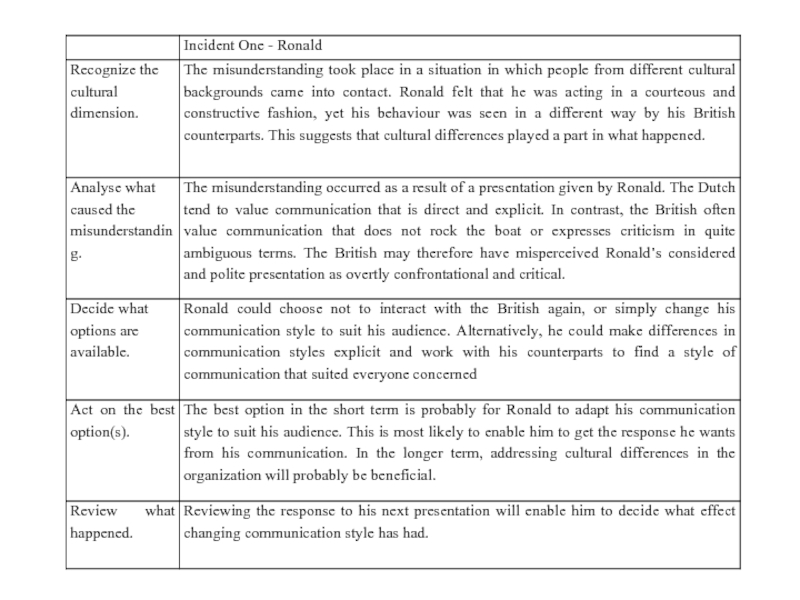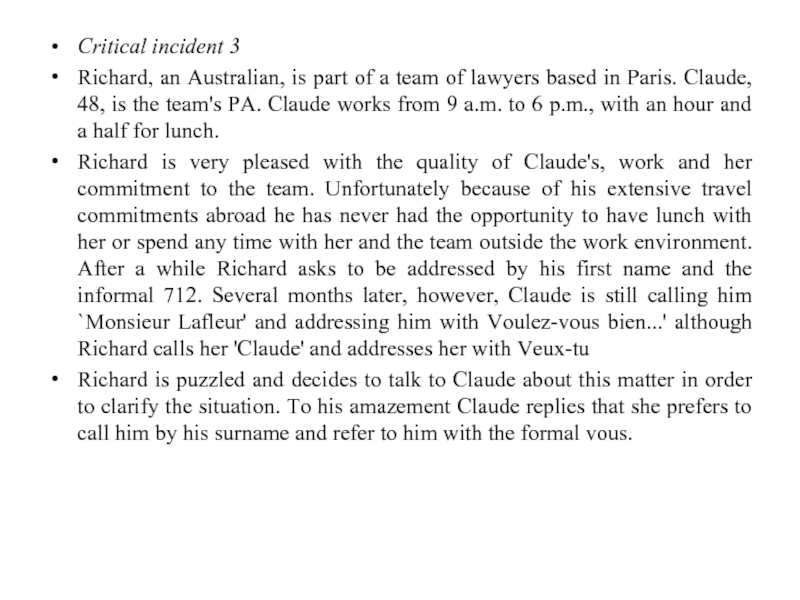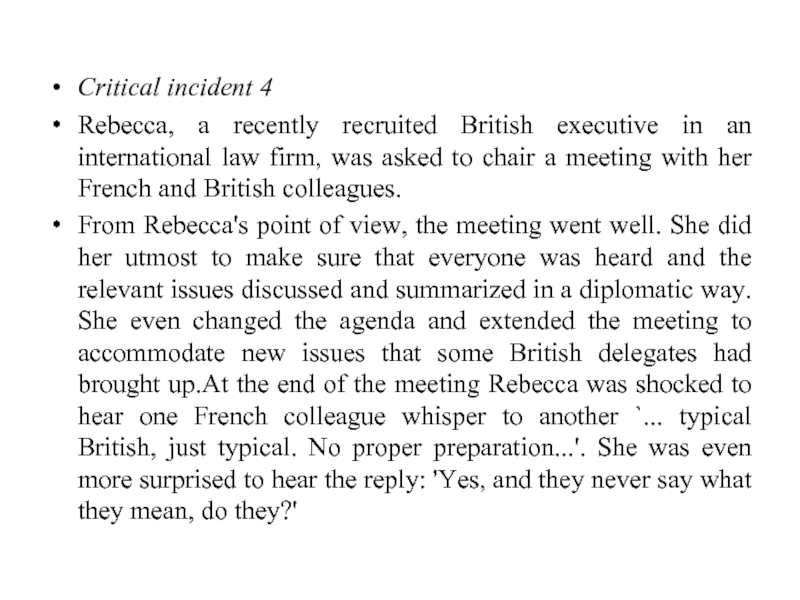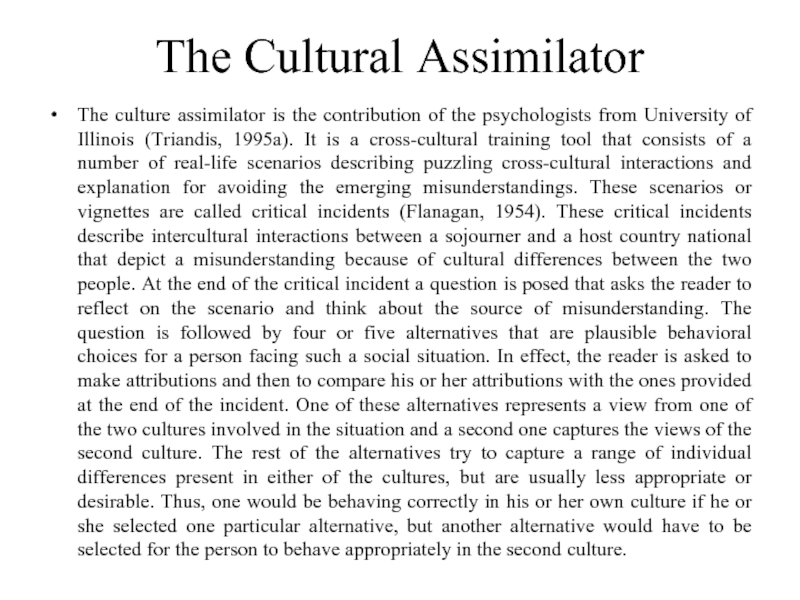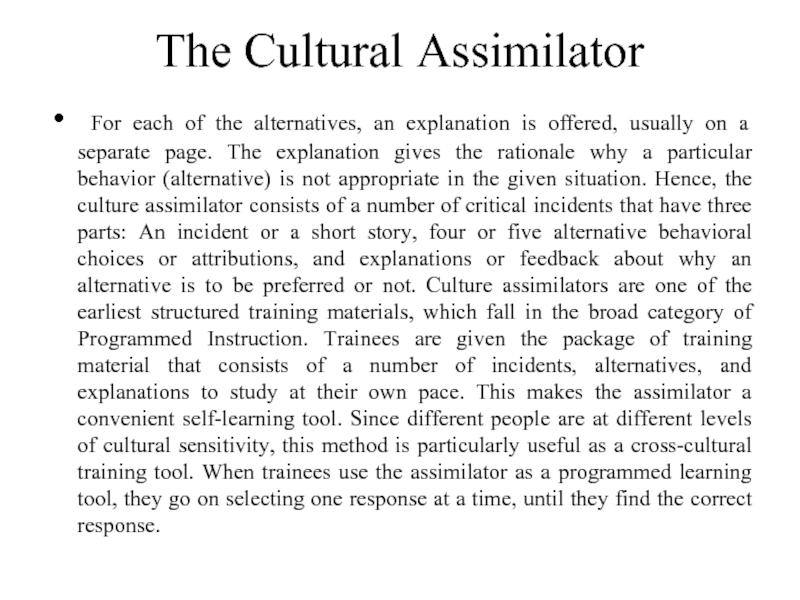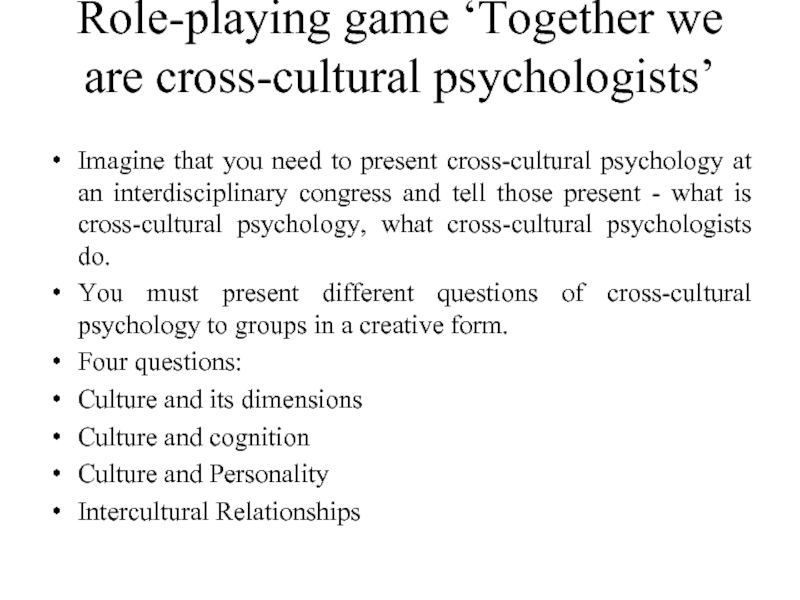communication (exercise Culture shock; Cross-cultural communication skills - the five-step ‘RADAR’ technique for recognizing and overcoming cross-cultural misunderstandings, The Cultural Assimilator)
Role-playing game ‘Together we are cross-cultural psychologists’
- Главная
- Разное
- Дизайн
- Бизнес и предпринимательство
- Аналитика
- Образование
- Развлечения
- Красота и здоровье
- Финансы
- Государство
- Путешествия
- Спорт
- Недвижимость
- Армия
- Графика
- Культурология
- Еда и кулинария
- Лингвистика
- Английский язык
- Астрономия
- Алгебра
- Биология
- География
- Детские презентации
- Информатика
- История
- Литература
- Маркетинг
- Математика
- Медицина
- Менеджмент
- Музыка
- МХК
- Немецкий язык
- ОБЖ
- Обществознание
- Окружающий мир
- Педагогика
- Русский язык
- Технология
- Физика
- Философия
- Химия
- Шаблоны, картинки для презентаций
- Экология
- Экономика
- Юриспруденция
Communication and Culture (the features of communication in different cultures) презентация
Содержание
- 1. Communication and Culture (the features of communication in different cultures)
- 2. Communication and Culture Instruction for groups
- 3. Communication and Culture Viewers assignments You
- 4. Culture shock An important element in dealing
- 5. Culture shock Culture shock is the process
- 6. Culture shock Exercise Below you will see
- 7. The five-step 'RADAR' technique for recognizing and
- 8. Example Critical incident 1 A manufacturing company
- 10. Critical incident 2 Sarah Marshall is
- 11. Critical incident 3 Richard, an Australian,
- 12. Critical incident 4 Rebecca, a recently
- 13. The Cultural Assimilator The culture assimilator is
- 14. The Cultural Assimilator For each of
- 15. Role-playing game ‘Together we are cross-cultural psychologists’
Слайд 1Рractice 05.12.2017
Communication and Culture (the features of communication in different cultures)
Intercultural
Слайд 3Communication and Culture
Viewers assignments
You will watch small scenes about communication in
business context in different cultures.
Your task is to determine
the situation of communication (whether it is formal or informal),
the roles of actors,
the status of actors ,
gender of actors,
age of actors,
distance of communication;
importance and usage of gestures;
importance and usage of facial expressions;
importance and usage of visual communication;
features of the organization of space and time,
other important features of communication in the scene.
After you look through each scene, you must describe the features of communication in this culture.
The participants of the scene will give you their comments.
Слайд 4Culture shock
An important element in dealing with culture shock is recognizing
that it is a natural process with a beginning point and a relatively clear set of stages progressing to a point at which it is no longer a problem for the person concerned.
Understanding the nature of these stages, and developing the skills to recognize which stage you have reached, is a useful strategy for managing individual reactions to culture shock. This exercise provides a handy checklist of stages and useful practice in recognizing what comments or perceptions may indicate about the stage of cross-cultural adjustment individuals are in.
Understanding the nature of these stages, and developing the skills to recognize which stage you have reached, is a useful strategy for managing individual reactions to culture shock. This exercise provides a handy checklist of stages and useful practice in recognizing what comments or perceptions may indicate about the stage of cross-cultural adjustment individuals are in.
Слайд 5Culture shock
Culture shock is the process of adjustment to an unfamiliar
culture. It is a more or less sudden immersion into a state of uncertainty - in which you become unsure about what is expected of you and what you can expect from other people. Culture shock can occur in any situation where you are forced to adjust to an unfamiliar system in which many of your previous ways of doing or understanding things no longer apply.
The five stages
Five stages of culture shock can be identified:
1. Honeymoon
This is where the newly arrived individual experiences the curiosity and excitement of a tourist, but where the person's basic identity is rooted back at home.
2. Disorientation
This stage involves the disintegration of almost everything familiar. The individual is overwhelmed by the requirements of the new culture and bombarded by stimuli in the new environment.
3. Shock
This stage is associated with the experience of anger and resentment towards the new culture. Stress, anxiety, irritation and hostility are common.
4. Adaptation
This involves the integration of new cues and an increased ability to function in the new culture. The individual increasingly sees the bad and the good elements in both the new culture and the home culture.
5. Adjustment
In this stage, the individual has become comfortable in both the old and the new culture. There is some controversy about whether anyone can really attain this stage.
The five stages
Five stages of culture shock can be identified:
1. Honeymoon
This is where the newly arrived individual experiences the curiosity and excitement of a tourist, but where the person's basic identity is rooted back at home.
2. Disorientation
This stage involves the disintegration of almost everything familiar. The individual is overwhelmed by the requirements of the new culture and bombarded by stimuli in the new environment.
3. Shock
This stage is associated with the experience of anger and resentment towards the new culture. Stress, anxiety, irritation and hostility are common.
4. Adaptation
This involves the integration of new cues and an increased ability to function in the new culture. The individual increasingly sees the bad and the good elements in both the new culture and the home culture.
5. Adjustment
In this stage, the individual has become comfortable in both the old and the new culture. There is some controversy about whether anyone can really attain this stage.
Слайд 6Culture shock
Exercise
Below you will see a number of comments likely to
be made by individuals in one of the five stages of culture shock. Read each comment and write down what stage of culture shock you think the individual concerned is most likely to be in.
Comment
1. 'We do that too, only in a different way.'
2. 'Why can't they just ...?'
3. 'I can't wait to tell ... about this.'
4. 'You don't understand them like I do.'
5. 'Isn't this exciting?'
6. 'These people are so damn ...'
7. 'Only ...more months before I can go home'
8. 'Aren't they interesting?'
9. 'Actually, I am beginning to like this'
10. 'Everything here is so difficult!'
11. 'We would never do that where I come from'
12. 'On the other hand, why shouldn't they do that?‘
Comment
1. 'We do that too, only in a different way.'
2. 'Why can't they just ...?'
3. 'I can't wait to tell ... about this.'
4. 'You don't understand them like I do.'
5. 'Isn't this exciting?'
6. 'These people are so damn ...'
7. 'Only ...more months before I can go home'
8. 'Aren't they interesting?'
9. 'Actually, I am beginning to like this'
10. 'Everything here is so difficult!'
11. 'We would never do that where I come from'
12. 'On the other hand, why shouldn't they do that?‘
Слайд 7The five-step 'RADAR' technique for recognizing and overcoming cross-cultural misunderstandings.
No matter
how well prepared someone may be for cross-cultural contact, misunderstandings can occur in any situation where individuals with different values, beliefs and ways of doing things interact. In these circumstances it is necessary to attempt to overcome misunderstandings in a structured and explicit fashion.
This activity introduces critical incidents describing cross-cultural misunderstandings and invites learners to work through these incidents using the RADAR technique.
This activity introduces critical incidents describing cross-cultural misunderstandings and invites learners to work through these incidents using the RADAR technique.
Слайд 8Example
Critical incident 1
A manufacturing company wanted to boost its flagging exports
to continental Europe. Ronald, a young Dutch marketing manager with a lot of experience in the Amsterdam office of the organization was seconded to the company's London headquarters for six months in order to help with a new marketing project. Ronald spent several weeks researching the marketing department's methods and talking to his counterparts. Eventually, he drew up a number of clear proposals for boosting European sales, which he intended to present at a senior management meeting. During the meeting Ronald explained what the problems were and what needed to be done to solve them.
At the end of the meeting Ronald asked if anyone had any comments or suggestions, and was a little surprised when everyone kept silent. A week later Ronald was transferred back to Amsterdam, even though he still had three months of his secondment to serve. Shortly afterwards, Ronald's manager in Amsterdam received a memo from head office suggesting that he be moved to a 'less sensitive' position in the company where he did not have to deal with clients or senior management.
At the end of the meeting Ronald asked if anyone had any comments or suggestions, and was a little surprised when everyone kept silent. A week later Ronald was transferred back to Amsterdam, even though he still had three months of his secondment to serve. Shortly afterwards, Ronald's manager in Amsterdam received a memo from head office suggesting that he be moved to a 'less sensitive' position in the company where he did not have to deal with clients or senior management.
Слайд 10
Critical incident 2
Sarah Marshall is head of the business development group
at a US-based law firm. Recently she was assigned the task of winning a contract for a new project with the Colombian government. She was competing with teams from Spain and France.
Sarah had quite a lot of background information on the proposed project and on the packages her competitors were offering. On the basis of this information and her organization's extensive resources she felt confident that the company would win the contract.
Sarah drew up a proposal that was time and cost-effective and designed a presentation based on convincing numbers and a persuasive argument. Arriving in Bogota the day before, Sarah personally made the sales pitch in which she detailed all the relevant facts, highlighted the various ways forward and made a clear recommendation of the best solution. She eventually lost the project to the Spanish team, even though her Columbian counterparts acknowledged the quality of her proposals.
Sarah had quite a lot of background information on the proposed project and on the packages her competitors were offering. On the basis of this information and her organization's extensive resources she felt confident that the company would win the contract.
Sarah drew up a proposal that was time and cost-effective and designed a presentation based on convincing numbers and a persuasive argument. Arriving in Bogota the day before, Sarah personally made the sales pitch in which she detailed all the relevant facts, highlighted the various ways forward and made a clear recommendation of the best solution. She eventually lost the project to the Spanish team, even though her Columbian counterparts acknowledged the quality of her proposals.
Слайд 11
Critical incident 3
Richard, an Australian, is part of a team of
lawyers based in Paris. Claude, 48, is the team's PA. Claude works from 9 a.m. to 6 p.m., with an hour and a half for lunch.
Richard is very pleased with the quality of Claude's, work and her commitment to the team. Unfortunately because of his extensive travel commitments abroad he has never had the opportunity to have lunch with her or spend any time with her and the team outside the work environment. After a while Richard asks to be addressed by his first name and the informal 712. Several months later, however, Claude is still calling him `Monsieur Lafleur' and addressing him with Voulez-vous bien...' although Richard calls her 'Claude' and addresses her with Veux-tu
Richard is puzzled and decides to talk to Claude about this matter in order to clarify the situation. To his amazement Claude replies that she prefers to call him by his surname and refer to him with the formal vous.
Richard is very pleased with the quality of Claude's, work and her commitment to the team. Unfortunately because of his extensive travel commitments abroad he has never had the opportunity to have lunch with her or spend any time with her and the team outside the work environment. After a while Richard asks to be addressed by his first name and the informal 712. Several months later, however, Claude is still calling him `Monsieur Lafleur' and addressing him with Voulez-vous bien...' although Richard calls her 'Claude' and addresses her with Veux-tu
Richard is puzzled and decides to talk to Claude about this matter in order to clarify the situation. To his amazement Claude replies that she prefers to call him by his surname and refer to him with the formal vous.
Слайд 12
Critical incident 4
Rebecca, a recently recruited British executive in an international
law firm, was asked to chair a meeting with her French and British colleagues.
From Rebecca's point of view, the meeting went well. She did her utmost to make sure that everyone was heard and the relevant issues discussed and summarized in a diplomatic way. She even changed the agenda and extended the meeting to accommodate new issues that some British delegates had brought up.At the end of the meeting Rebecca was shocked to hear one French colleague whisper to another `... typical British, just typical. No proper preparation...'. She was even more surprised to hear the reply: 'Yes, and they never say what they mean, do they?'
From Rebecca's point of view, the meeting went well. She did her utmost to make sure that everyone was heard and the relevant issues discussed and summarized in a diplomatic way. She even changed the agenda and extended the meeting to accommodate new issues that some British delegates had brought up.At the end of the meeting Rebecca was shocked to hear one French colleague whisper to another `... typical British, just typical. No proper preparation...'. She was even more surprised to hear the reply: 'Yes, and they never say what they mean, do they?'
Слайд 13The Cultural Assimilator
The culture assimilator is the contribution of the psychologists
from University of Illinois (Triandis, 1995a). It is a cross-cultural training tool that consists of a number of real-life scenarios describing puzzling cross-cultural interactions and explanation for avoiding the emerging misunderstandings. These scenarios or vignettes are called critical incidents (Flanagan, 1954). These critical incidents describe intercultural interactions between a sojourner and a host country national that depict a misunderstanding because of cultural differences between the two people. At the end of the critical incident a question is posed that asks the reader to reflect on the scenario and think about the source of misunderstanding. The question is followed by four or five alternatives that are plausible behavioral choices for a person facing such a social situation. In effect, the reader is asked to make attributions and then to compare his or her attributions with the ones provided at the end of the incident. One of these alternatives represents a view from one of the two cultures involved in the situation and a second one captures the views of the second culture. The rest of the alternatives try to capture a range of individual differences present in either of the cultures, but are usually less appropriate or desirable. Thus, one would be behaving correctly in his or her own culture if he or she selected one particular alternative, but another alternative would have to be selected for the person to behave appropriately in the second culture.
Слайд 14The Cultural Assimilator
For each of the alternatives, an explanation is
offered, usually on a separate page. The explanation gives the rationale why a particular behavior (alternative) is not appropriate in the given situation. Hence, the culture assimilator consists of a number of critical incidents that have three parts: An incident or a short story, four or five alternative behavioral choices or attributions, and explanations or feedback about why an alternative is to be preferred or not. Culture assimilators are one of the earliest structured training materials, which fall in the broad category of Programmed Instruction. Trainees are given the package of training material that consists of a number of incidents, alternatives, and explanations to study at their own pace. This makes the assimilator a convenient self-learning tool. Since different people are at different levels of cultural sensitivity, this method is particularly useful as a cross-cultural training tool. When trainees use the assimilator as a programmed learning tool, they go on selecting one response at a time, until they find the correct response.
Слайд 15Role-playing game ‘Together we are cross-cultural psychologists’
Imagine that you need to
present cross-cultural psychology at an interdisciplinary congress and tell those present - what is cross-cultural psychology, what cross-cultural psychologists do.
You must present different questions of cross-cultural psychology to groups in a creative form.
Four questions:
Culture and its dimensions
Culture and cognition
Culture and Personality
Intercultural Relationships
You must present different questions of cross-cultural psychology to groups in a creative form.
Four questions:
Culture and its dimensions
Culture and cognition
Culture and Personality
Intercultural Relationships
